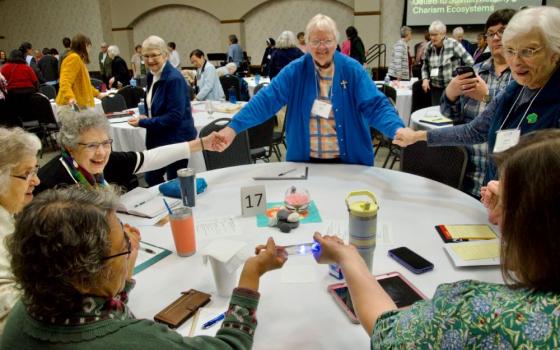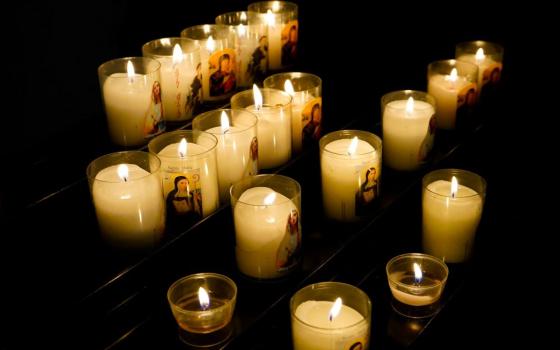
A small memorial to the 12 sisters who died in one month from COVID-19 sits in the gardens outside the Felician Sisters' convent in Livonia, Michigan. (GSR photo/Dan Stockman)

Editor's note: On Holy Thursday, Pope Francis prayed for the dead as well as for the priests, doctors and nurses who he said represented the "saints next door" during the coronavirus pandemic. Over the next months, National Catholic Reporter and Global Sisters Report will be bringing the stories of Catholics in this crisis: those who have died, but also those whose service brings hope. To submit names of people for consideration for this series, please send a note to saintsnextdoor@ncronline.org.
They were teachers. A librarian. A director of religious education. A secretary in the Vatican Secretariat of State. The author of a 586-page history of the congregation.
One was an organist. One helped her second-grade class write and perform a commercial for Campbell's Soup. One was a nurse and led nursing students' mission trips to Haiti.
All of them were members of the Congregation of the Sisters of St. Felix of Cantalice, or Felician Sisters. They lived together, prayed together and worked together.
And in one awful month — from Good Friday, April 10, to May 10 — 12 sisters died of COVID-19. Eighteen other Felician Sisters at the convent in Livonia, Michigan, had the illness caused by the novel coronavirus, as well.
"We couldn't contain the grief and the sorrow and the emotional impact," said Sr. Noel Marie Gabriel, director of clinical health services for the Felician Sisters of North America. "We went through the motions of doing what we had to do, but that month was like a whole different way of life. That was our most tragic time. It was a month of tragedy and sorrow and mourning and grieving."
But as the world grapples with the economic and social fallout of the continuing pandemic, survivors are discovering that the virus can cause lasting damage and recovery may not mean a return to full health: One of the 18 sisters who initially survived the illness died from its effects June 27, making her the 13th victim in the Livonia convent.
Though sisters worldwide have died from the virus, no one is tracking how many. News reports show that, as of July 16, in addition to the 13 Felicians in Livonia, at least 19 other sisters have died in the United States, including a Felician sister at the order's convent in Lodi, New Jersey; six sisters from two communities at a shared convent outside Milwaukee, Wisconsin; and three Maryknoll Sisters in Ossining, New York.

The convent of the Felician Sisters in Livonia, Michigan, where 12 sisters died of COVID-19 in one month. (GSR photo/Dan Stockman)
Internationally, at least 61 sisters have died, including 10 Comboni Sisters in northern Italy, seven Sisters of Sainte-Croix in Montreal, seven Ursuline sisters outside Montreal, six Sisters of St. Anne in Quebec, and six Little Missionary Sisters of Charity in northern Italy.
In the United States, the 13 Felicians lost in Livonia may be the worst loss of life to a community of women religious since the 1918 influenza pandemic. And in many ways, because of the restrictions in place to prevent a return of the virus, sisters' grieving has yet to begin.
All aspects of community are still either prohibited or severely limited. Sisters could not attend the funerals. There are limits on the number of people allowed in the chapel. They cannot enter each other's rooms. They had been eating one sister to a table, dining in three different shifts.
As of July 6, they are back to two to a table. But all the other restrictions still apply.
The community had 65 sisters before the pandemic. Now, the remaining sisters fear the day they can be together as a group and see how many are no longer there.
"I get chills thinking about that," said Sr. Mary Andrew Budinski, the superior of the Livonia convent. "The raw grief is yet to come, I think."

Local minister Sr. Mary Andrew Budinski looks at the memorial to remember the 12 sisters who died in one month from COVID-19 that sits in the gardens outside the Felician Sisters' convent in Livonia, Michigan. (GSR photo/Dan Stockman)
'It went through like wildfire'
As the pandemic progressed across the United States in March, so did the restrictions at the convent: no visitors, no shopping trips, no group activities.
At first, there was no Mass, only Communion services, because the priest was not allowed to enter the convent. Then, Communion services were canceled, and Communion was distributed to the sisters in their rooms. On April 9, Holy Thursday, even that ended.
"We all knew if it hit the place, it would be bad. But we never anticipated how quickly it would go."
—Sr. Mary Ann Smith
Sr. Joyce Marie Van de Vyver said as the restrictions progressed, suppressing the community life the sisters held so dear, Communion became more and more important, making it even more difficult when distribution was ended.
"We have a much stronger sense of belief and acceptance of the validity of spiritual communion," she said. "That's all we had."
The 360-acre campus was home to 800 sisters in the 1960s, but convent life today has become concentrated around the chapel and the two halls where sisters live. Much of the sprawling building, dating to 1937, is unused.

Felician Sr. Joyce Marie Van de Vyver on June 10 in the order's convent in Livonia, Michigan (GSR photo/Dan Stockman)
The first floor of St. Joseph Hall, a three-story wing of the convent, is dedicated to sisters who need 24-hour nursing care. The second floor is for assisted living, and the third floor, independent living.
Though visitors were prohibited beginning March 14, the convent kept essential staff members, including nurses, nurse's aides and dining hall workers. Then, staffers started getting sick.
"I first heard two aides had contracted the virus," Sister Andrew said. "We don't know who they are, and we don't want to know. Then it hit sisters on the second floor, and it went through like wildfire."
Then came the first death: Sr. Mary Luiza Wawrzyniak, 99, on Good Friday, April 10.
"We all knew if it hit the place, it would be bad," Sr. Mary Ann Smith. "But we never anticipated how quickly it would go."
A new reality began. Almost all of the many traditions the sisters keep when one of their own dies had to be suspended. There could be a funeral, but only 10 people could attend. If they also went to the graveside, they had to travel one to a car. There would be no hugs.
"That whole part of the closure process has yet to be realized," Sister Joyce said.
When sisters fell ill with COVID-19, the other sisters could not take care of them. They couldn't see them, talk to them or comfort them.
"The faith we share with sisters as they are dying, the prayers we share with sisters as they are dying: We missed all that. It kind of shattered our faith life a little bit."
—Sr. Joyce Marie Van de Vyver
Sr. Nancy Jamroz, a table companion of Sister Luiza's at meals, said no one knew Sister Luiza had the virus. She went to the hospital for heart palpitations.
"Everyone said, 'She'll be back in a few days,' " Sister Nancy said. "She never came back."
That became a pattern. One sister would go to the hospital overnight because she could not breathe but would call in the morning to say she was feeling better and would be home in two or three days. Then would come the news that she had died.
"It was the classic case of what we had heard about the virus," Sister Nancy said. "It's vicious, and it's quick."
The community lost four other sisters in that first week. Sr. Celine Marie Lesinski, 92, and Sr. Mary Estelle Printz, 95, died on Easter Sunday, April 12, two days after Sister Luiza. Sr. Thomas Marie Wadowski, 73, followed April 15. Then Sr. Mary Patricia Pyszynski, 93, on April 17.

Like many congregations, much of the sprawling convent of the Felician Sisters in Livonia, Michigan, is unused, as the number of sisters has fallen over the years. (GSR photo/Dan Stockman)
Sister Nancy said accepting the reality of what was happening to the community was hard. Required isolation meant the sisters heard of their friends' deaths over the intercom during the daily 1 p.m. announcements.
"You started to become numb," Sister Nancy said. "You were caught between the Twilight Zone and la-la land. ... When this is death No. 8, this is No. 9, it just became a numbing participation."
The lack of closure perpetuated the feeling that none of this was real.
"Part of our tradition is to tell stories of the sister who died on the night we have the vigil, sharing happy moments we had together," Sister Nancy said. "You get a copy of their bio and a holy card, but none of that has happened. It feels like that door is still open."
Sister Joyce said when faith is rooted in tradition, a break in those traditions seems to change everything.
"The faith we share with sisters as they are dying, the prayers we share with sisters as they are dying: We missed all that," she said. "It kind of shattered our faith life a little bit."
Interactive timeline of events (click the arrows to scroll a slideshow or click on specific dates in the timeline):
'None of us are the same'
Closing the convent was anathema to the sisters. They had dedicated their lives to serving others. So March 13, the day before the doors were shut to the outside world, 10 of the sisters went to the chapel steps and held up a banner to the Livonia community that said, "We're lifting you up in prayer."
"We are not hidden behind these walls," Sister Joyce said. "We will always continue to pray for the world and especially the people of Livonia."
But now, it's turned around, she said. "Now it's: 'Sister, we're praying for you.' The number of cards and letters we've received is unbelievable."
They also believe there are others praying for them who cannot be seen: the sisters who died.
"There are some days when I say, 'God, we have 12 sisters up there, just like the 12 apostles," Sister Nancy said June 10, before the community's death toll rose to 13. "Anyone who knew those sisters knows they have companions [in heaven] now. They're looking down, letting us know it's going to be OK."
"I don't think it's a coincidence that all of this began in Lent, and the worst of it started during Holy Week," Sister Mary Ann said. "All of us as a community had to go through a total death."

Felician Sr. Mary Ann Smith climbs a staircase in the order's convent in Livonia, Michigan, where 12 sisters died from COVID-19 in one month. (GSR photo/Dan Stockman)
It's not yet clear in what ways, but each member of the community has changed, she said.
"We haven't been together enough to know how, but we're different people than we were in March," she said. "None of us are the same."
Some of them, including Sister Mary Ann, thought their lives were not just changing, but ending. She had the virus from mid-April until the end of May.
"I was so sick, I would pray the Lord would take me, I was in so much pain," she said.
Sister Andrew also thought she had reached the end. She was sick for a month, from mid-April to mid-May.
"I really thought I was going to die," she said. "I surrendered to that. I said, 'God, if you're going to take me, I'm ready.' Then I woke up the next morning and I was still alive. Then somehow, I got better."
The virus seemed to be as random as it was fast.
"We had sisters in their late 90s who survived and sisters much younger who went," said Sr. Mary Serra Szalaszewicz. "Their ministries were over. The others must still have some ministry to perform, some function yet to do."

Felician Sr. Mary Serra Szalaszewicz on June 10 in the order's convent in Livonia, Michigan (GSR photo/Dan Stockman)
Those who survived, however, do not know why.
"You ask, 'Why am I here when these other sisters are gone?' " Sister Mary Ann said. "I value the time I've been given, but I'm not sure what to do with it yet."
Sr. Bernadette Marie Jimkoski, who was sick all of April, said it's hard to find meaning in any of it.
"When I was going through [the illness], there were times I was angry at God. Like, 'Why are you doing this?' " she said. "There were other times I wanted to die."
The community lost three sisters in three days in mid-April: Sr. Mary Clarence Borkoski, 83, on April 20; Sr. Rose Mary Wolak, 86, on April 21; and Sr. Mary Janice Zolkowski, 86, on April 22.
"They weren't giving us numbers," Sister Andrew said. "Just every day, they'd say, 'Another sister.' 'Another sister.' 'Another sister.' It was very frightening."
The Felicians have 469 sisters in six large convents in North America. Of those, only the convents in Livonia and Lodi had cases of COVID-19. Lodi had 12 cases of the virus, with one death.
"That's what I'm proud about," Sister Noel Marie said. "Because we learned what to do, we were able to save all those sisters from this."
"We just kept going. We had to help sisters survive and protect the sisters who didn't have it from getting it."
—Sr. Noel Marie Gabriel
It wasn't easy.
"Like the rest of the elder-care populations, we struggled with getting appropriate [personal protective equipment]. We're not a licensed agency, so we were not at the front of the list for getting any," she said. "It's not that we couldn't purchase it. It wasn't there to purchase."
Despite not being a licensed facility, Sister Noel Marie said the care sisters get at the convent is second to none.
"We meet and exceed a 5-star nursing home," she said. "We exceed staffing ratios. We exceed the longevity of staff. ... We staff 24/7 better than nursing homes. We do the best practices."
The virus also hit the staff caring for the sisters. One sister was believed to have the virus, but the nurse caring for her stayed with her anyway, despite the risk to herself. Another staff member caught the virus but had an elderly relative at home, so she lived in a guest room at the convent for weeks until she recovered.
And there were volunteers, those who willingly came from across the country to work in a place where death stalked the hallways.

The first floor of the care center in the Felician Sisters' convent in Livonia, Michigan, has many empty rooms after COVID-19 killed 12 sisters in one month. Many of the sisters who died lived on the first floor. (GSR photo/Dan Stockman)
"One worked in HR but was also a nurse's aide. She got here and went right on the floor to work. ... They would leave their families and put themselves at risk for us — and this was at the height of the virus," Sister Andrew said.
People never seemed to go home, working six or seven days a week.
Sister Noel Marie said it helped not to think about it.
"We just kept going," she said. "We had to help sisters survive and protect the sisters who didn't have it from getting it. We really hunkered down."
Advertisement
What's left behind
Not thinking about the grief and just doing what needs to be done is a common coping mechanism in times of great trauma. But eventually, the trauma must be dealt with.
"We all have post-traumatic stress," Sister Noel Marie said. "Not full-blown post-traumatic stress syndrome, but some indications of it. People couldn't grieve because of the urgency of getting through it. Now, we've got bad dreams, high anxiety, emotional distress."
The ordeal needs to be discussed and people need to tell their stories, she said, but it's difficult because they still cannot be together.
"That grieving and mourning and talking — we've got to keep talking about it and sharing about it in any way we can," Sister Noel Marie said. "I tell them, 'Each of you has your own personal story and our communal story, and all those need to come out.' "
Sister Serra, who, like Sister Mary Ann, was sick from mid-April until the end of May, said she found comfort in her faith.
"I had this image of the Good Shepherd; you know, the image where he's carrying the sheep on his shoulders," she said. "Only he was carrying each of our sisters. And I knew then everything was going to be all right.
The first floor of the care center looks like the hallway of any nursing home in America. But this one is too quiet — most of the sisters who died lived on the first floor.
"We just can't walk down that first-floor hallway yet," Sister Joyce said. "There's a story connected to each bedroom, and they're [nearly] all empty."
Sister Nancy has been to the first floor, but it's difficult.
"So many empty rooms," she said. "You go by and you say, 'That's Luiza's room, that's Patricia's room.' But they're empty."
Those who still live on the first floor are coping with additional loss. Sisters from other floors are normally dedicated to visiting those who live there but now are only allowed to stand in the doorway. Because most sisters on the first floor are hard of hearing, visitors in the doorway must speak loudly or shout. Phone calls rarely work for the same reason. It's easier for some to simply stay away.

An empty room on the first floor of the care center in the Felician Sisters' convent in Livonia, Michigan. Many of the sisters who died from COVID-19 lived on the first floor. (GSR photo/Dan Stockman)
"What our sisters long for is to be together," Sister Noel Marie said. "Together in the chapel. Together for Communion. Together for prayer in the morning and in the evening. To dine together. Because that's who we are."
The end of April saw the loss of three more sisters. Sr. Mary Alice Ann Gradowski, 73, died April 25. Sr. Victoria Marie Indyk, 69, died the next day, April 26, and Sr. Mary Martinez Rozek, 87, followed on April 28.
Sr. Mary Madeleine Dolan, 82, died May 10, exactly one month after Sister Luiza. Sr. Mary Danatha Suchyta, 98, one of the sisters thought to have survived the illness, died from its effects June 27.
There were days when sisters were not sure what was real, especially after weeks of quarantine. Were the deaths announced over the intercom really happening? What name did they just say?
"I got a call from Sister Madeleine. She said, 'I don't want to die,' " Sister Bernadette Marie said. "Those were her last words to me. Two days later, she was gone."

Felician Sr. Bernadette Marie Jimkoski on June 10 in the order's convent in Livonia, Michigan (GSR photo/Dan Stockman)
In addition to the quarantine, there was the time-bending illness.
"One sister said she lost three days," Sister Nancy said. "She has no idea what happened. Those days are just gone."
Sister Mary Ann, stuck in her room in isolation for five weeks when she was sick, would pretend she was talking to the sisters in the hospital.
"Especially Vicki. I talked to her a lot" after she went to the hospital, Sister Mary Ann said. "I told her, 'If you want to go, it's OK. Go be with your mother.' "

Felician Sisters pray at Eucharistic adoration in one of the chapels June 10 at the order's convent in Livonia, Michigan, days after they were allowed to use the chapel again under strict social distancing rules. (GSR photo/Dan Stockman)
The next morning, though, it wasn't clear at the convent whether Sister Vicki had died or made it through the night.
"I said, 'I need to know. I need to know if you're gone,' " Sister Mary Ann said.
Then, she looked out her window and saw a huge bird flying straight toward her. When it came close, it extended its wings and seemed to hover for a moment right at her window.
"I know now it was just a hawk flying around, but on that day, I knew [Sister Vicki] was at peace with the Lord," she said.

Felician Sr. Mary Ann Smith explains a display in the Felician Heritage Room at the order's convent in Livonia, Michigan. (GSR photo/Dan Stockman)
'We'll let the Spirit lead us'
In the middle of that awful month, the Felician Sisters across the continent gathered on a Zoom call to their sisters in Livonia. They brought a message of comfort, of community, a message of love. They remembered the sisters lost in a slideshow. The Livonia sisters said they wept through the entire thing.
And when it's all over, they plan to hold a celebration of life for the 13 sisters they lost. They don't know what the celebration will entail or even when they'll be able to have it, but they know how important it will be.
"We'll let the Spirit lead us through that," Sister Nancy said.
In the meantime, there is still the semi-quarantine to deal with. The last person came out of a 28-day isolation June 8, but there are still many restrictions. Sister Serra said everyone's stockpiles — toothpaste, candy — have been used up.
"We're down to our last Hershey bars," Sister Joyce said.
But no one will be going to the store anytime soon.
"I look at it like an accordion that can open and close, and right now, that accordion is still really tightly closed," Sister Noel Marie said. "We're not touching each other, not hugging, not doing the things we usually do. ... We miss that part of how we live. It's on a cellular level for us."
[Dan Stockman is national correspondent for Global Sisters Report. His email address is dstockman@ncronline.org. Follow him on Twitter or on Facebook.]










